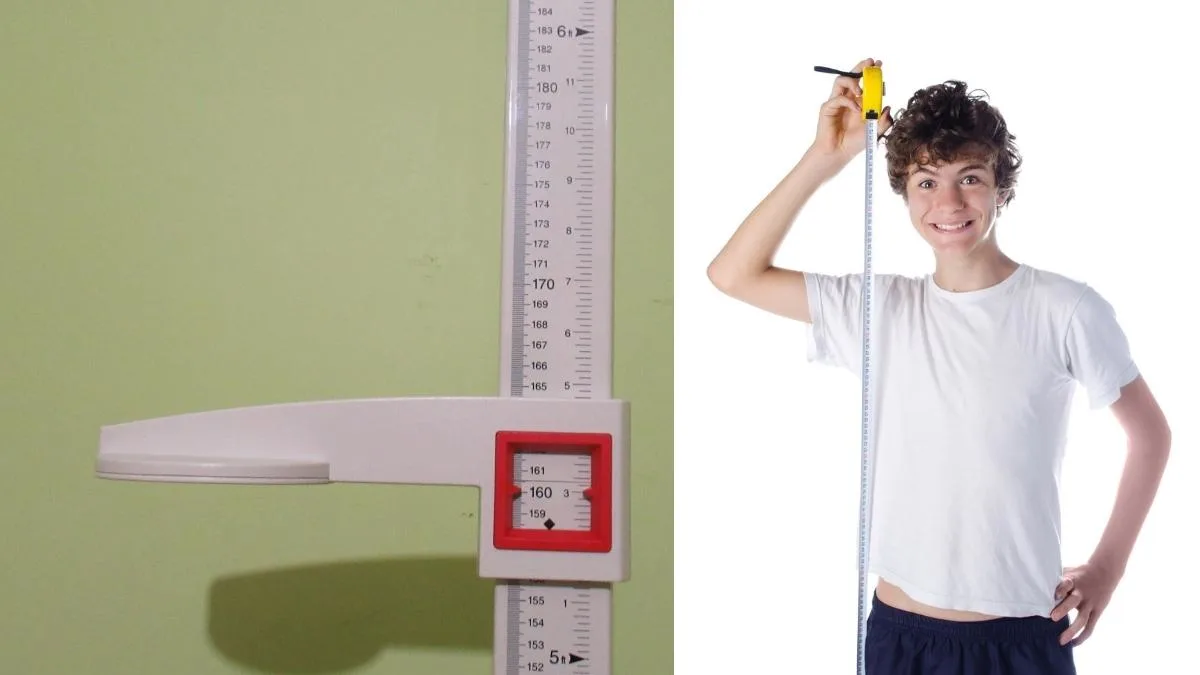If you really want to know how to get taller at 16—and you definitely can—then this article is the one for you.
We analyzed the height measurement data of thousands of American teenagers and came to the conclusion that, despite what some people say, 16 year olds can increase their height.
More Growing Guides:
- Average height for 16 year olds
- How to grow taller
- How much taller will I grow at 10?
- How much taller will I grow at 11?
- How much taller will I grow at 12?
- Can I still grow taller at 13?
- Can I still grow taller at 14?
- Can I still grow taller at 15?
- Can I still grow taller at 17?
- Can I still grow taller at 18?
How to get taller at 16 years old for boys

At the age of 16, most boys have not completed their physical development, meaning that there’s still a chance to add inches to your stature if you’re not yet an adult. [1]
Statistically, the typical 16 year old boy will gain around an inch of height between the ages of 16 and 17.
Of course, some males grow faster and slower than others, meaning that some sixteen year old boys will stop increasing in height before or after their peers.
The main ways to get taller as a 16 year old boy are to consume foods like dairy, fish, and poultry, as well as fruits and vegetables. Research shows that these foods can boost IGF-1 levels, which is an important growth hormone that’s produced primarily in the liver. [2]
Eating a variety of foods is important for nourishing your body, so make sure to eat fruits and vegetables of various colors as well as varied sources of protein.
Red meat and shellfish, for example, are very high in zinc, which is crucial for maximizing your height growth. But on the other hand, fatty fish and pasture-raised poultry are packed with omega-3s, which are vital for maintaining optimal health and brain functioning.
Sleep is, of course, of paramount importance because this is the restful period of time when growth hormone is secreted the most. So make sure to get around 9 hours of sleep each day in order to allow your growing body to develop.
How to increase height at 16 for girls

In truth, most girls won’t get any taller after the age of 16. This is the case no matter what you do because once your growth plates fuse, you won’t gain any more height.
Still, not every girl stops growing at 16. And since living a healthy lifestyle is a good thing anyway, you may as well look after your health at the age of 16 because it certainly won’t hurt your potential height development.
For guidance on sleep and diet, see the section above for boys or the penultimate section on food below.
For now, let’s tackle exercise—something that most teenagers don’t get enough of.
Exercise is crucial for maximizing your health and physical development, and research shows that girls tend to perform less physical activity than boys. [3]
This may not be the case in every population group, but it’s food for thought. The same study also showed that people who spend a lot of time on screens tend to perform less physical activity as well.
Conveniently, minimizing screen usage before bed can help you to get a better night’s sleep, which, as noted, is a crucial period of time because that’s when growth hormone is secreted in large amounts.
Aim for 60 minutes of daily exercise, performing a combination of strength training (burpees, squats, push-ups) and aerobic exercises (swimming, running on the spot, sports) across the week.
How much do you grow after 16?

Now that you know how to grow taller at 16 let’s talk about how much height you can expect to gain after the age of sixteen.
Based on the data, a 16 year old boy can expect to gain an inch of height after turning 16, whereas a 16 year old girl won’t gain any significant amount of stature.
If you have the genetics to grow tall, however, then you might gain multiple inches of height.
While we preach the importance of setting yourself up for height growth success with a healthy diet and proper sleeping habits, your genetics largely determine both your final height and how much height you can add to your frame at any given age.
Can you have a growth spurt at 16 years old?

Yes, it’s definitely possible to have a growth spurt at 16 years old. However, statistically, by the age of 16, most teenagers have done the vast majority of their growing.
Other than ensuring you get quality sleep each night, perform plenty of exercise, and get good nutrition, there’s no way that you can actively “trigger” a growth spurt by doing special exercises or following a particular diet.
Sure, some types of exercises, such as sprinting, release more HGH than others. But it’s unlikely that this temporary growth hormone boost—which you can still get from other forms of exercise—will lead to noticeable increases in height.
Does skipping increase your height after 16?

Does skipping increase your height after 16? Although skipping is good exercise, jumping rope does not directly increase your height after age 16 or at any age.
Still, skipping is a great form of exercise that you can do almost anywhere. It’s highly recommended for those 16 year olds who don’t go to the gym but who still want to improve their health and fitness levels.
Does basketball increase your height after 16?

Does basketball increase your height after 16? No, basketball definitely does not directly increase height at the age of 16.
Basketball is, however, a great form of exercise because it gives you a good workout while giving you the chance to mix with people and get out of the house.
You will, of course, notice that many basketball players are very tall. But their impressive stature isn’t due to the fact that they play and have played a lot of basketball.
The reverse of this is true; these people are tall and, therefore, they decide to play basketball because, due to their height, they naturally excel at this particular sport.
What are some good exercises to get taller at 16?

If you want to grow taller at 16, then you should aim for an hour of daily physical activity, ideally at a moderate to vigorous intensity.
Providing that you perform both aerobic activity and resistance training throughout the week, the exact workouts, providing that they’re safe, don’t matter.
In the interest of consistency and compliance with your exercise routine, this is why we recommend doing workouts that you enjoy—you’re more likely to work out when you enjoy the physical training.
That said, let me give you some good ideas.
If you’re short on equipment, try running on the sport, running up (but not down) the stairs, or jumping jacks for cardiovascular activity.
Other types of aerobic activity that can give you a growth hormone boost to grow taller at 16 include swimming, cycling, track, and many other sports.
As for resistance training, which is important for building and maintaining muscle and bone strength, resistance bands are often just as good as free weights. But if you have no equipment at all, you can do squats, lunges, calf raises, push-ups, and burpees.
What are some good foods to increase your height after 16?

Some good foods to increase your height at 16 years old are dairy, lean meats, red meats, fish, eggs, beans, fruits, and vegetables.
You also want to make sure that your body has enough energy, so eat other nutrient-dense foods, like nuts, seeds, and sweet potato, as well as the likes of meat, dairy, and poultry.
A good breakfast would be oatmeal mixed with nuts or seeds and topped with various fruits. For more protein, you could also have a bowl of yogurt.
In conclusion: Can you still grow taller at 16 years old?
So, can you still grow taller at 16 years old? Yes, it’s definitely possible to grow taller at 16 if your growth plates are still open.
Most 16 year old boys will get a bit taller, but the majority of 16 year old girls won’t add any height after turning 16 (nor after turning 15, in many cases).
Now that you know exactly how to get taller at 16, it’s just a case of seeing if your genetics produce any additional height growth. Try not to stress about your stature too much because stress is definitely not good for your well-being when it becomes chronic.
References
- Your Son at 16: Milestones. (2017, May 3). WebMD. Retrieved from https://www.webmd.com/parenting/guide/son-16-milestones
- Giovannucci, E., Pollak, M., Liu, Y., Platz, E. A., Majeed, N., Rimm, E. B., & Willett, W. C. (2003). Nutritional predictors of insulin-like growth factor I and their relationships to cancer in men. Cancer epidemiology, biomarkers & prevention : a publication of the American Association for Cancer Research, cosponsored by the American Society of Preventive Oncology, 12(2), 84–89.
- Bhatti, S. N., Watkin, E., Butterfill, J., & Li, J. M. (2020). Recognition of 16-18-Year-Old Adolescents for Guiding Physical Activity Interventions: A Cross-Sectional Study. International journal of environmental research and public health, 17(14), 5002. https://doi.org/10.3390/ijerph17145002

